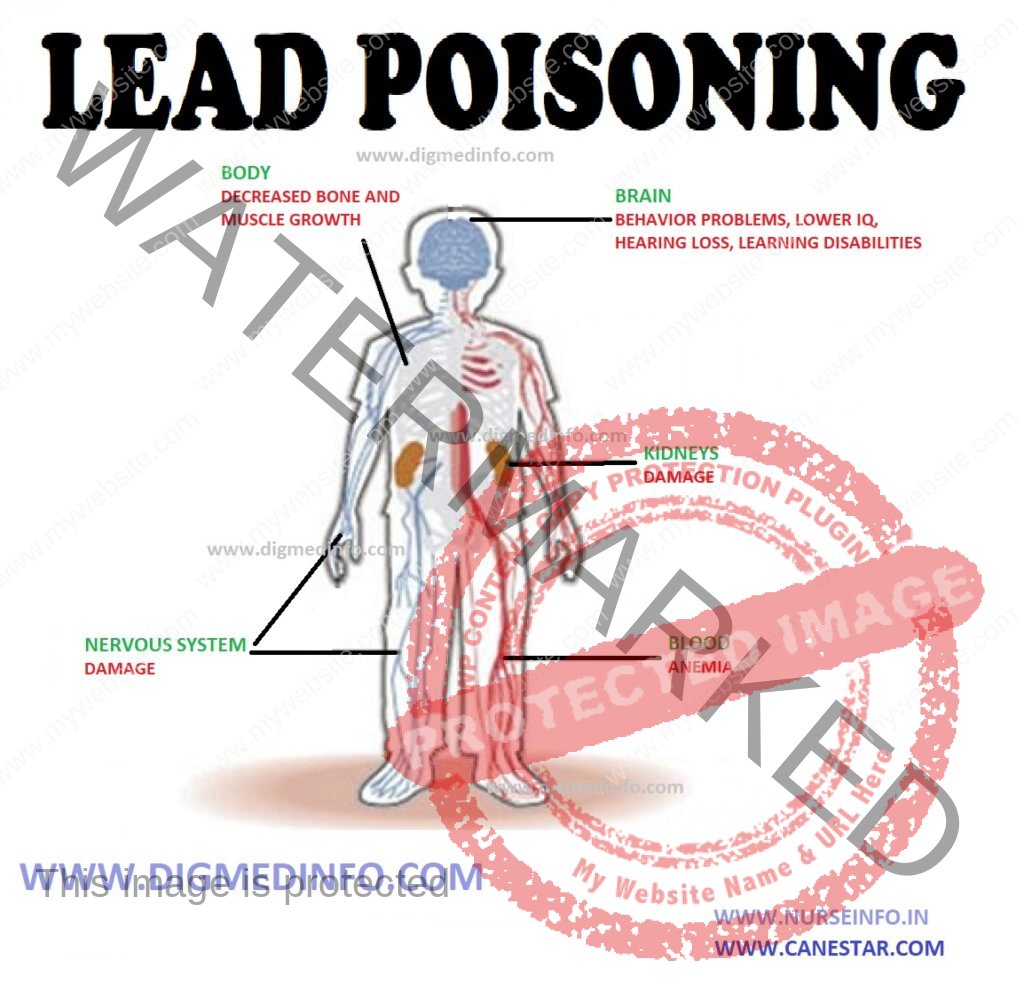LEAD POISONING – General Features, Treatment, Chronic Lead Poisoning – Diagnosis, Treatment and Prevention
General Features
Lead poisoning may occur in households among children and in industrial workers. Lead is widely used in paints, storage batteries, petrol and several industries. Ingestion, inhalation or absorption from the skin may lead to acute poisoning. Workers engaged in printing, lead smelting, ship building, tank cleaning are at risk of developing chronic toxicity. Children may eat flaked paint as a form of pica. Lead accumulates in the body and it is deposited in bone and other tissues.
Acute lead poisoning Initial symptoms are metallic taste, irritation of throat, salivation and intense thirst. These are soon followed by colicky abdominal pain, painful spasm of abdominal muscles, hematemesis and constipation. The stools are black due to the formation of lead sulphide. More serious cases develop drowsiness, headache, and muscular cramps, and convulsions, paralysis of lower limbs, hemolysis and renal failure.
Treatment
Calcium disodium versenate (EDTA) in a dose of 1 g in 250 to 500 mL of 5% dextrose intravenously twice daily (50 mg/kg/d) for 8-10 days or longer helps to eliminate the lead. Symptomatic treatment is indicated as the condition warrants.
Chronic lead poisoning (Plumbism)
The main symptoms are abdominal colic, constipation, hemolytic anemia, paralysis and cerebral, cardiac and renal damage. It manifests initially as tubular damage going on to chronic renal failure. There is no threshold level for lead to initiate toxicity. Severe intestinal colic and constipation may be mistaken for other alimentary disorders.
Most on the lead and blood is present in erythrocytes. In chronic, lead poisoning the lead is deposited in cortical bone. Lead impairs the enzyme delta-aminolevulinic acid dehydrogenase which is needed for haem synthesis. Moderate to severe hemolytic anemia occurs. The peripheral blood shows punctate basophilia and reticulocytosis. In long term lead poisoning, the lead is deposited in cortical bone. Motor neuropathies manifest as wrist drop and foot drop. Shoulder girdle muscles may be affected rarely. Sensory symptoms are usually absent.
Lead encephalopathy manifests as headache, loss of memory, epileptiform convulsions and coma. Optic neuritis may occur. Urine may show protein, delta amino levulinic acid, and coproporphyrin III. Blood pressure is elevated. Deposition of lead in the gingival margins results in the formation of a black line in people with poor oral hygiene.
In edentulous subjects this lead line (Burtonian line) does not form. Chronic renal failure may develop. It manifests initially as tubular damage, later, tubular atrophy and interstitial nephritis. Exposure to lead during intrauterine life leads to erosion of cognitive skills with subclinical but permanent reduction in IQ. This may result is permanent impairment in performance standards in adult life.
Diagnosis
The clinical diagnosis is confirmed by the elevated levels of lead in blood. Levels above 80 mcg/Dl are diagnostic. A test for chronic lead accumulation is EDTA mobilization test. Urinary loss of >600 mcg of lead in 72 hours indicates lead poisoning.
Treatment
In severe toxicity, EDTA is administered as described earlier. In less severe cases, other than EDTA an oral chelator, Succimer (dimercaptosuccinic acid) has been used in a dose of 10mg/kg orally every 8 hours for 5 days.
Prevention
Proper washing of the hands before eating and provision of protective clothing and masks reduce absorption of lead. Provision of 300 mL of milk to such workers may be helpful in reducing toxicity. Persons working in risky occupations should be periodically monitored. Pollution of the environment by lead salt is a major concern in recent years. The use of lead in automobile fuels has resulted in the discharge of appreciable amounts of lead into the atmosphere. In many states of India the use of leaded petrol is restricted.


